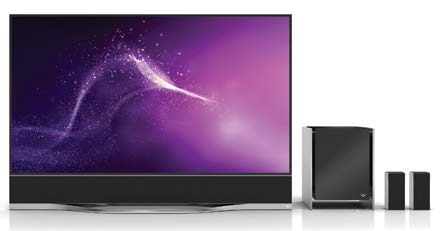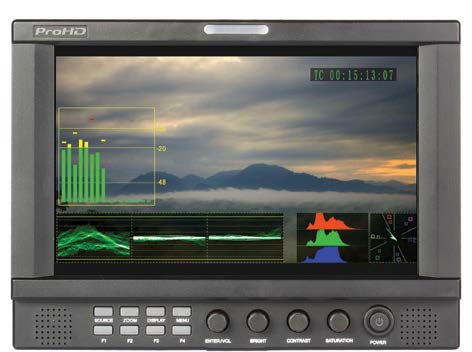Monitors Respond to New Image Demands
OTTAWA, ONTARIO—As both broadcast and consumer electronics industries push forward with UHD and 4K resolution, monitor manufacturers are looking at how techniques such as high dynamic range will affect the overall picture. In fact, Canon, Dolby, Sony, and Vizio have already launched their own HDR/4K monitors, and more will likely be in the pipeline as interest in HDR and 4K heats up. And while not all monitor companies are doing HDR yet, most are adding a number of new features for the professional monitor market.
A SMALL TRICKLE

Vizio’s “Reference Series” monitors are among the first on the market to feature HDR with Dolby Vision playback technology. The 2015 NAB Show saw a handful of production HDR/4K reference monitors on display, including Canon’s 24-inch DPV2410 and 30-inch DP-V3010, Dolby’s Dolby Vision 32-inch monitor; Sony’s 30-inch BVMX300, and Vizio’s 65-inch and 120-inch monitors, which run on the Dolby Vision system.
Given that HDR/4K has yet to penetrate the broadcast world, it may seem counterintuitive for manufacturers to be offering HDR/4K reference monitors so early. But these units do have a place in today’s TV production environment, according to Gary Mandle, senior product manager for Sony Electronics. “There are post houses who are working in 4K today—especially for feature films—who can definitely benefit from having an HDR/4K reference monitor to see every single aspect of their image contrast,” he said. “Broadcasters would also be well-advised to have access to a BVMX300, so that they can get to know HDR/4K before the ATSC 3.0 standard is finalized.”
Currently in the standards development process, ATSC 3.0 will make it possible for broadcasters to transmit HDR/4K signals over the air. The downside is that ATSC 3.0 is not backwards compatible with today’s ATSC 1.0 transmission equipment.
Roland Vlaicu, vice president for Dolby’s Consumer Imaging division expects that the company’s Dolby Vision HDR/4K technology—which Dolby is licensing to manufacturers such as Vizio—will gain traction in the near-term with consumers and video producers alike. “I think equipment will need to be HDR-capable in the next few years to be included in OB trucks,” Vlaicu added. “It can still be set to operate in SDR [standard dynamic range] now, but it must have the room to step up to HDR in the future.”
Canon’s 24-inch DP-V2410 reference display is equipped with a Canon-designed RGB LED backlight with a 10-bit IPS panel and antiglare coating to support a wide-viewing angle. It has a specially developed image-processing engine to deliver uniform brightness, with 4096x2160 resolution and 17:9 aspect ratio and can display high contrast and rich-mid tones of HDR content ordinary not visible to SDR. Canon’s 30-inch DP-V3010 has a DCI-compliant contrast ratio of 2000:1; a 16:10 aspect ratio and 4096x2560 (V) resolution. The Sony 30-inch BVMX300 uses a Sony manufactured RGB OLED panel that offers 4096x2160 resolution, at a 17:9 aspect ratio. It has settings to display HDR as SMPTE ST2084 and also display the new ITU-R BT2020 wide color gamut.
The professional video industry's #1 source for news, trends and product and tech information. Sign up below.
WAIT AND SEE

JVC recently released its new DT-X92 line of ProHD LCD monitors for field and studio. JVC, another provider of monitors to the professional market, is waiting to see what kind of demand arises for professional HDR/4K monitors before taking the plunge. “HDR is still on our workbench,” said Craig Yanagi, manager of marketing and brand strategy for JVC Professional Video. “We are still waiting to have that dialogue.”
In the meantime, JVC has unveiled six new ProHD LCD monitors for field/studio use, including a dual 9-inch rack display. These new DT-X92 monitors will replace corresponding DT-X91 models in the JVC ProHD monitor lineup. The DT-X92HX2 has two 9-inch LCD HDTV (1900x1200 resolution) panels with embedded audio meter, scale markers, SDI time code, and customer-editable video title displays. Meanwhile, the DT-X92F single 9-inch LCD HDTV monitor has the same features plus adds on-screen waveform, vector scope, and RGB histogram. JVC also offers larger models in 15.6-, 21.5-and 23.8-inch sizes. All can be powered by DC or AC power.
Although aimed at the digital signage market, Marshall Electronics’ 12.1-inch DV-1204 monitor may be useful to broadcasters for a number of interior applications. Offering 1200x800 resolution and compatibility with a range of HDMI/VHA connections, the DV-1204 is perfect for “always-on” situations. “We have engineered the DV-1204 to run for 50,000 hours,” said Perry Goldstein, director of multimedia sales for Marshall Electronics in El Segundo, Calif. That works out to 5.7 years’ service on a continuous 24/7 basis.
James Careless is an award-winning journalist who has written for TV Technology since the 1990s. He has covered HDTV from the days of the six competing HDTV formats that led to the 1993 Grand Alliance, and onwards through ATSC 3.0 and OTT. He also writes for Radio World, along with other publications in aerospace, defense, public safety, streaming media, plus the amusement park industry for something different.

